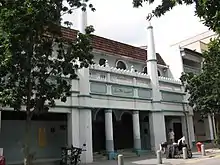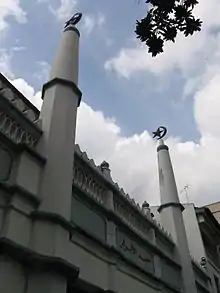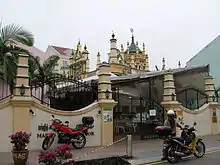Masjid Al-Abrar
Masjid Al-Abrar (Malay for Al-Abrar Mosque; Jawi:مسجد الأبرار) is a mosque located along Telok Ayer Street in Chinatown within the Central Area, Singapore. It is one of the earliest mosques in Singapore. The mosque is also known by two other names – Kuchu Palli and Masjid Chulia. Al-Abrar is its official name, while Kuchu Palli, meaning "hut mosque" in Tamil,[1] is a reflection of the mosque's first modest structure. Its location in Telok Ayer Street, in the heart of Chinatown, was where Chulia immigrants from the Coromandel Coast of South India, among the earliest immigrants to Singapore, settled when they came to Singapore, hence, Masjid Chulia.[2] Note however that another mosque, Masjid Jamae, is also commonly called Masjid Chulia.[3]
| مسجد الأبرار Masjid Al-Abrar Al-Abrar Mosque | |
|---|---|
Masjid Al-Abrar, Kuchu Palli | |
 | |
| Religion | |
| Affiliation | Islam |
| Location | |
| Location | 192 Telok Ayer Street Singapore 068635 |
| Geographic coordinates | 1.280278°N 103.847222°E |
| Architecture | |
| Type | Mosque |
| Style | Indo-Islamic |
| Date established | 1827 |
| Completed | 1855 |
| Designated as NHL | |
| Designated | 19 November 1974 |
The building was gazetted as a national monument on 19 November 1974.[4]
History

The early Tamil immigrants first established the Masjid Al-Abrar in 1827 with a makeshift thatched hut that they used for worship until it was replaced by a brick building between 1850 and 1855.[2] An 1856 painting by Percy Carpenter, entitled Telok Ayer Street as seen from Mount Wallich, features an early visual record of the brick mosque.[4] In 1829, the congregation of the mosque was granted a 999-year lease for the land on which the mosque stood. The lease was held in trust by Hadjee Puckery Mohamed Khatib. In 1910, five new trustees were appointed. They were K. Mohamed Eusope, Thambyappa Rarooter, S. Kanisah Maricayar, V.M. Kader Bux and J. Sultan Abdul Kader. The trustees were responsible for all three Chulia mosques: Masjid Al-Abrar, Masjid Jamae and Nagore Durgha.[2]
Occupying the width of three shophouse fronts, the mosque was aligned with the street grid that conveniently is also oriented towards Mecca.[4] Inside, the mosque is essentially a one-storey prayer hall. It is much simpler than its earlier counterparts in Singapore.
The mosque remained in this form for over a century, with only minor repairs from the 1950s to the mid-1980s. Between 1986 and 1989, major renovations were carried out, and the capacity was expanded to allow up to 800 worshippers in the mosque.[4] An adjacent shophouse was converted into a madrasa and a prayer hall for women in 1998.[2]
Masjid Al-Abrar was designated a national monument on 19 November 1974. The mosque is currently administered by the Islamic Religious Council of Singapore.[4]
Architecture
The design of the building is based on Indo-Islamic architecture with two tall minarets at the front. The minarets-like towers that define the narrow frontage are devoid of decorative elements, except for a small onion dome on the top of each tower. The building however also includes Neoclassical elements such as Doric columns in its interior.[4]
The building was built along a row of shophouses, and the frontage incorporated a five-foot way (1.524 m) that connects the walkway of the other shophouses.[4] At the entrance of the mosque, the parapet that previously fringed only the central bay now ran across the whole length of the frontage. The parapet features an architrave, a frieze with mouldings and panels, a balustrade and Islamic cresting echoing that found on Masjid Sultan. The courtyard that used to lie between the entrance gate and the prayer hall was covered, with part of it converted into a gallery extension. Originally single-storeyed, the prayer hall has been extended to two storeys, with a gallery on the upper floor, and capped with a huge jack roof. While later changes are extensive, the designers took their cue from the original style, proportions and materials used in the old mosque to ensure that the new look is cohesive.
Transportation
The mosque is accessible within walking distance from Telok Ayer MRT station.
References
- Jane Beamish; Jane Ferguson (1 December 1985). A History of Singapore Architecture: The Making of a City. Graham Brash (Pte.) Ltd. pp. 57–58. ISBN 978-9971947972.
- "Al-Abrar Mosque". Singapore Infopedia. National Library Board.
- "Jamae Mosque". Your Singapore.
- "Al-Abrar Mosque". Roots. National Heritage Board.
- National Heritage Board (2002), Singapore's 100 Historic Places, Archipelago Press, ISBN 981-4068-23-3
External links
| Wikimedia Commons has media related to Masjid Al-Abrar. |

